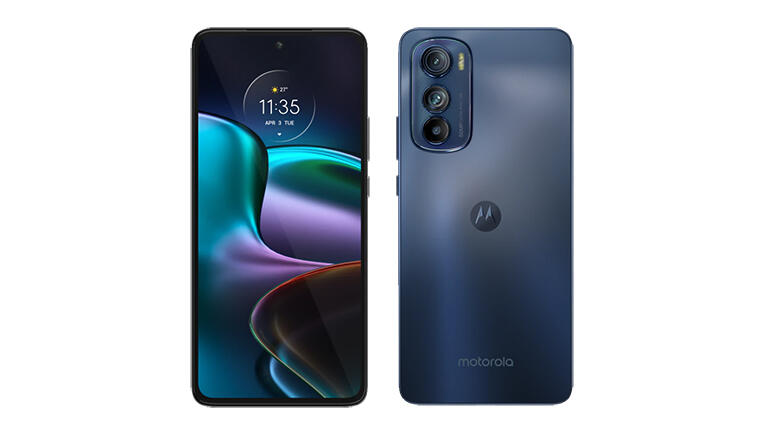As far as looks go, the Moto Edge 30 punches above its weight. It’s available in just one colour, which Motorola calls Meteor Grey, although it’s actually rather bluish in tone. The back is plastic rather than glass, but it still tends to pick up finger marks. The 6.5-inch screen sits in slim bezels, and the handset measures 159.38 mm tall and 74.236 mm wide. That results in a claimed screen to body ratio of 87.6%, although we calculated it at 86.2%. The Edge 30 weighs 155g and has an extremely thin profile at just 6.79mm. Obviously this means that the rear camera bump protrudes significantly, resulting in instability on the desktop when the screen is pressed. Motorola provides a clear plastic bumper, which although it obscures the Meteor Grey livery, does provide both protection and stability. Dust and water ingress are prevented, to some degree, thanks to an IP52 rating (‘dust protected’ and resistant to ‘dripping water’). The screen is this phone’s most impressive feature. It’s a 6.5-inch AMOLED display with FHD+ resolution (2,400 x 1,080, 20:9, 405ppi), HDR10+ support and a maximum refresh rate of 144Hz. This can be set to be always on, or you can opt for 60Hz at all times, or let the handset handle the refresh rate automatically. I found the screen clear and sharp on auto mode. There is an in-display fingerprint sensor. Unfortunately the speakers don’t live up to the screen in terms of quality. They pump out plenty of volume, but audio is rather tinny and lacking in bass tones. There’s no 3.5mm headset jack. There are three cameras at the back: 50MP f/1.8 wide angle with OIS; 50MP f/2.2 ultra-wide angle (118°); and a 2MP f/2.4 depth sensor. You can shoot 4K video at 30fps, 1080p video at up to 120fps and 720p video at up to 960fps. The front camera is a 32MP f/2.25 unit that can shoot 4K video at 30fps. SEE: Best cheap 5G phone 2022: No need to pay flagship prices for quality devices The test photos I shot were acceptable as everyday snaps, and the front-facing camera, sitting in the top centre of the screen, takes good enough selfies. My limited night-time testing revealed some weaknesses, with over-exposed lights and brighter areas, and under-exposed darker areas. The Motorola Edge 30 is powered by Qualcomm’s mid-range Snapdragon 778G+ 5G chipset with 8GB of RAM. This platform turned in Geekbench 5 CPU scores of 819 (single core) and 2843 (multi core). That’s pretty respectable, given that leading-edge handsets currently score around 1000 and 3500 respectively. The Edge will accommodate two Nano-SIMs, but there is no support for a MicroSD card to boost the 111GB of storage that remains when the OS has taken its share of the installed 128GB. Motorola provides a refreshingly light-touch Android 12 install without bloatware. The Edge 30’s 4020mAh battery kept the handset running for just 7 hours and 22 minutes under the PCMark for Android Work 3.0 battery life test. The 33W ‘TurboPower 33’ charger is no match for the 150W chargers of leading flagship handsets, but you’ll need to keep it handy for top-ups during the day if you’re running any demanding workloads. Motorola’s Edge 30 is something of a mixed bag. It’s very slim and light, with the 144MHz AMOLED screen the star of the show, along with decent mid-range performance. It looks smart enough, although the build quality reflects its affordable pricing. Other trade-offs include the lack of MicroSD storage expansion, moderate battery life and so-so cameras – especially in low-light conditions. Motorola Edge 30 specifications
Alternatives to consider
As the cost of living rises, many smartphone buyers are shifting their focus from expensive flagships to mid-range and budget handsets. There’s an increasing range of choice at lower price points – here are three leading contenders.
RECENT AND RELATED CONTENT
Motorola Moto G Stylus 5G review: Exactly as advertised
Motorola Edge Plus review: Mid-range experience for flagship price
Counterpoint: Motorola becomes number three smartphone maker in US
The 5 best cheap phones: Flagship features for under $450
The 6 best cheap 5G phones: Top picks under $450
Read more reviews
Blackview Tab 12: You can buy 4 of these impressive Android tablets for the price of the iPad AirNintendo Switch OLED Model review: The one to beatM1 MacBook Air long-term review: A year later, here’s what I wish I’d knownAsus ExpertBook B7 Flip review: A well-connected 5G-equipped business 2-in-1Pulsefire Haste Wireless and Pulsefire Mat review: A match made in heaven
